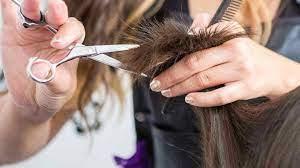The world of hair cutting and styling is constantly evolving, with new Hair Cutting Techniques and trends emerging all the time. One of the latest methods to gain popularity is the "dry cutting" technique. This new method of hair cutting is becoming increasingly popular due to its ability to create a natural, effortless look.
What is Dry Cutting?
Dry cutting is a technique that involves cutting the hair without wetting it first. Traditionally, hair cutting has been done on wet hair, as it is easier to see the individual strands and create precise, even cuts. However, with dry cutting, the hair is cut in its natural state, allowing the stylist to see how the hair falls and moves.
Dry cutting is particularly effective for creating textured, layered styles, as the natural movement of the hair is used to create a more natural, lived-in look. The technique is also ideal for curly and wavy hair types, as it allows the stylist to see how the hair naturally curls and falls.
Benefits of Dry Cutting
One of the main benefits of dry cutting is its ability to create a more natural, effortless look. By cutting the hair in its natural state, the stylist can create a style that looks like it has grown out over time, rather than a precise, blunt cut.
Dry cutting also allows the stylist to see how the hair naturally falls and moves, which can be particularly effective for creating layered styles. By cutting the hair in layers, the stylist can create a more voluminous, textured look that adds dimension to the hair.
Another benefit of dry cutting is that it can be less damaging to the hair than wet cutting. Wet hair is more vulnerable to breakage and damage, as it is more elastic and fragile when wet. Dry cutting eliminates the need to use excessive tension on the hair, which can help to prevent damage and breakage.
How is Dry Cutting Done?
Dry cutting is a technique that requires a skilled stylist who is familiar with the natural movement and texture of hair. To begin the process, the stylist will start by examining the hair to determine its natural texture and movement. They will then use their scissors to create a shape that complements the hair's natural texture and movement, taking into account the client's desired style.
The stylist will typically use a variety of cutting techniques, including point cutting and slide cutting, to create a textured, layered look. Point cutting involves cutting the hair at an angle, creating a softer, more natural look. Slide cutting involves using the scissors to slide down the hair shaft, creating a more graduated, textured look.
Once the stylist has created the desired shape and texture, they may use a variety of styling products to enhance and define the style. This can include texturizing sprays, mousses, and pomades, which can help to add volume and definition to the hair.
In conclusion, dry cutting is a new and innovative method of hair cutting that is becoming increasingly popular. This technique allows stylists to create natural, textured styles that complement the hair's natural movement and texture. It is particularly effective for creating layered styles and is ideal for curly and wavy hair types. By eliminating the need to wet the hair before cutting, dry cutting can be less damaging to the hair and can create a more effortless, natural look. If you're looking to try a new Hair Cutting Techniques, dry cutting may be the perfect option for achieving a fresh, modern style.
